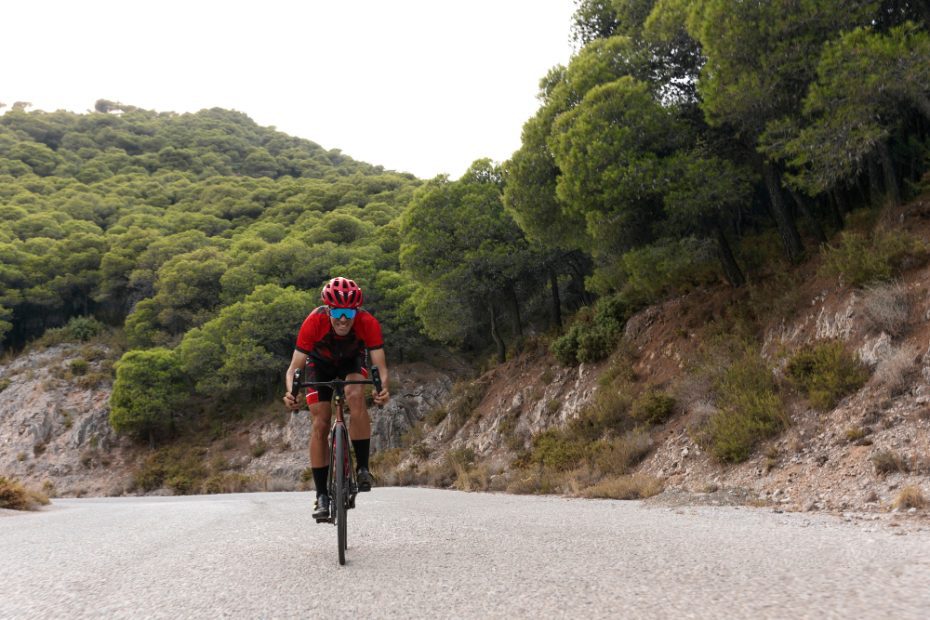Why do I struggle to cycle up hills?
Cycling up hills can be a challenging task for many cyclists, leaving them wondering why they struggle in these uphill battles. If you find yourself huffing and puffing, while others effortlessly glide up the incline, there are several factors that could contribute to your difficulty. In this article, we will explore some of the common reasons why individuals may struggle to cycle up hills and provide insights on how to overcome these challenges.
1. Fitness Level
One of the most obvious reasons for struggling to cycle uphill is a lack of fitness. Cycling uphill requires extra effort and stamina, as you are pushing against gravity to ascend. If you haven’t been training regularly or incorporating hill workouts into your cycling routine, it’s natural to find uphill climbs more demanding. Building cardiovascular endurance and leg strength through targeted exercises and regular rides can help improve your uphill performance.
2. Gearing and Bike Setup
The gear ratio and setup of your bike can also significantly impact your ability to tackle hills. Using the correct gearing allows you to maintain a consistent pedaling cadence, preventing your legs from tiring too quickly. If your bike’s gears are not properly adjusted or if you’re using gears that are too difficult for the gradient, you may find yourself struggling. Consider consulting a bike specialist to ensure your bike is set up correctly for hill climbing.
3. Technique
Efficient cycling technique plays a crucial role in conquering hills. It’s essential to distribute your effort evenly, utilizing your entire pedal stroke rather than relying solely on your quadriceps. Engage your core, relax your upper body, and try to maintain a steady rhythm. Leaning slightly forward and keeping your weight centered over the bike can provide stability and prevent unnecessary strain.
4. Mental Approach
Conquering hills is not just a physical challenge; it can also be a mental battle. Negative thoughts and self-doubt can hinder your performance. Instead, adopt a positive mindset and focus on small milestones rather than the daunting entirety of the climb. Visualize yourself successfully reaching the top and stay motivated with encouraging self-talk.
Remember, as Greg LeMond, former professional cyclist, once said, “It doesn’t get easier, you just go faster.”
5. Weather Conditions
Weather conditions can impact your uphill cycling experience. Strong headwinds or adverse weather such as rain or snow can make climbing more difficult. Be aware of the weather forecast before embarking on your ride and adjust your strategy accordingly. Dress appropriately for the conditions and consider revising your route if necessary.
6. Nutrition and Hydration
Proper nutrition and hydration are essential to maintain energy levels during uphill cycling. Ensure you are well-fueled before tackling a challenging ascent. A balanced diet that includes carbohydrates for energy and adequate hydration can significantly impact your performance. Consider consuming energy-rich snacks or sports drinks during longer climbs to sustain your energy levels.
In conclusion, there are several reasons why you may struggle to cycle up hills. Lack of fitness, incorrect bike setup, inefficient technique, negative mindset, adverse weather, and inadequate nutrition and hydration can all contribute to the difficulty. By addressing these factors through training, bike adjustments, improved technique, mental preparation, and taking care of your body’s needs, you can overcome these challenges and tackle hills with greater confidence.
Why do I get so tired biking uphill?
Cycling uphill can be a challenging and exhausting task, leaving many cyclists wondering why they feel so tired during this particular activity. There are several factors that contribute to this fatigue:
1. Physical demands
Biking uphill requires more effort than cycling on flat terrain. As you pedal against gravity, your muscles need to work harder to overcome the resistance. This increased workload can quickly lead to fatigue.
2. Cardiovascular strain
When cycling uphill, your heart has to pump more blood to deliver oxygen and nutrients to your working muscles. This places additional strain on your cardiovascular system, causing you to feel tired more quickly.
3. Muscle fatigue
As you continuously pedal uphill, specific muscle groups, such as your quadriceps and calves, are under constant stress. Over time, these muscles can become fatigued, leading to a decrease in power output and an increase in tiredness.
4. Energy expenditure
Biking uphill requires more energy compared to cycling on flat ground. Your body needs to burn more calories to sustain the effort, which can contribute to feelings of tiredness.
5. Inefficient technique
Using an inefficient cycling technique or maintaining a poor posture while climbing can further contribute to fatigue. It is essential to maintain a proper pedaling cadence, engage your core muscles, and distribute your weight evenly to conserve energy.
6. Lack of conditioning
If you’re new to cycling or haven’t trained specifically for uphill riding, your body may not be accustomed to the demands it places on your muscles and cardiovascular system. With regular training and gradual progression, your endurance and strength will improve.
7. Mental fatigue
Psychological factors also play a role in feeling tired when cycling uphill. The physical challenges and the perceived difficulty of conquering steep inclines can quickly drain your mental energy, leading to feelings of exhaustion.
8. External conditions
External factors such as weather conditions, heat, or altitude can impact your energy levels and make uphill cycling even more challenging. It’s important to consider these factors and adjust your effort accordingly.
9. Nutrition and hydration
Proper nutrition and hydration are crucial for maintaining energy levels during any physical activity. Ensure you consume enough carbohydrates for fuel and stay hydrated to minimize fatigue during uphill cycling.
10. Overtraining
Overtraining, pushing yourself too hard, or not allowing enough time for adequate recovery can lead to persistent fatigue when cycling uphill. It’s essential to listen to your body and incorporate rest days into your training routine.
“Cycling uphill is a challenging task that places additional strain on your muscles, cardiovascular system, and energy reserves.”
Why am I so weak at cycling?
1. Lack of strength and conditioning
One possible reason for feeling weak while cycling is a lack of overall strength and conditioning. Cycling requires the activation of various muscle groups, including the legs, core, and upper body. If these muscles are not adequately trained and conditioned, it can lead to feelings of weakness and fatigue during rides.
2. Improper bike fit
The right bike fit plays a crucial role in ensuring optimal performance and comfort while cycling. If your bike is not properly adjusted to suit your body proportions and biomechanics, it can lead to inefficient pedaling and increased strain on certain muscle groups, causing weakness and discomfort.
3. Insufficient fueling and hydration
Proper nutrition and hydration are essential for maintaining energy levels and endurance during cycling. If you’re not fueling your body with the right nutrients and fluids before, during, and after rides, it can result in fatigue, weakness, and difficulty in performing at your best.
4. Inadequate training and technique
Cycling, like any other sport, requires proper training and technique to improve performance. If you haven’t focused on specific training programs or techniques to develop cycling-specific skills and strengths, you may feel weaker compared to others who have dedicated time to improving their abilities.
5. Physical limitations or medical conditions
Some individuals may experience weakness in cycling due to underlying physical limitations or medical conditions. Factors such as low muscle mass, cardiovascular issues, or respiratory problems can affect performance and make cycling more challenging. Consulting with a healthcare professional can help identify and address any underlying issues.
6. Mental barriers
The mental aspect of cycling plays a significant role in performance. If you constantly doubt your abilities or have negative self-talk during rides, it can impact your overall strength and confidence. Building mental resilience and adopting positive mindset techniques can help overcome such mental barriers.
7. Lack of experience
Cycling is a skill that improves with practice and experience. If you’re relatively new to cycling or haven’t had much exposure to different terrains or long rides, it’s natural to feel weaker compared to more seasoned cyclists. Consistent riding and gradually challenging yourself can help build strength and endurance over time.
8. Overtraining or inadequate recovery
Overtraining without allowing adequate rest and recovery can lead to feelings of weakness and fatigue during cycling. It’s important to strike a balance between training intensity and recovery to give your body enough time to repair and adapt to the demands of cycling.
9. Inadequate warm-up and cool-down
A proper warm-up before a ride and a cool-down afterward can help prepare your muscles for exercise and aid in recovery. Neglecting these essential components can result in muscle weakness and increased risk of injury.
10. External factors
External factors such as weather conditions, road surfaces, or traffic can also contribute to feelings of weakness while cycling. Adapting to these elements and making necessary adjustments to your riding style can help mitigate their impact on your performance.
“Cycling is a physically demanding sport that requires proper training, nutrition, and mental resilience to perform at your best.” – Cycling Coach
To overcome weakness in cycling, it’s important to address these various factors and take a holistic approach to your training and preparation. By focusing on strength and conditioning, proper bike fit, nutrition, technique, and mental fortitude, you can gradually improve your performance and enjoy cycling to its fullest.
Is riding a bike uphill bad for your knees?
Many cyclists wonder whether riding a bike uphill is bad for their knees. The answer to this question depends on various factors, including your fitness level, biking technique, and pre-existing knee conditions.
Fitness Level
The difficulty of cycling uphill can put strain on your knees, especially if you’re not accustomed to intense physical activity. However, with regular training and gradually increasing the intensity of your rides, your muscles and joints can become stronger and better able to handle the challenge.
Biking Technique
Your biking technique also plays a role in protecting your knees while cycling uphill. It’s important to maintain proper form, including keeping your knees aligned with your feet and avoiding excessive strain on your joints. Applying smooth pedal strokes and shifting to easier gears when necessary can help reduce the stress on your knees.
Pre-existing Knee Conditions
If you already have knee problems, such as arthritis or previous injuries, uphill cycling might exacerbate your symptoms. In such cases, it’s essential to consult with a healthcare professional or a physiotherapist who can advise you on how to modify your biking routine to minimize discomfort.
Remember: It’s crucial to listen to your body and pay attention to any signs of pain or discomfort. If you experience persistent knee pain while cycling uphill, it’s recommended to take a break and seek medical advice if necessary.
“Cycling uphill can be challenging for your knees, but with proper conditioning, technique, and awareness of any pre-existing knee conditions, it can be a rewarding and beneficial exercise.”
Additionally, incorporating strength training exercises that target the muscles supporting your knees, such as quadriceps and glutes, can help improve your overall knee stability and reduce the risk of injury.
To summarize, riding a bike uphill does put some strain on your knees, but with the right approach, it can be a valuable workout that strengthens your lower body. By gradually increasing your fitness level, maintaining proper technique, and considering any pre-existing knee conditions, you can enjoy the benefits of uphill cycling while minimizing the potential impact on your knees.
Why is biking uphill harder than walking?
The Science Behind It
Biking uphill can be a challenging task compared to walking due to several scientific factors at play.
When you walk, your body weight is evenly distributed between both legs as you push off the ground with each step. This distributes the effort and energy required to move forward more evenly throughout your body. In contrast, when you cycle uphill, most of the effort is concentrated on your legs as you pedal against gravity and resistive forces such as wind resistance. This places a greater strain on your leg muscles and cardiovascular system.
Additionally, biking involves an element of balance and coordination that walking does not require, making it more physically demanding.
The Muscles Involved
Biking uphill requires the activation of several major muscle groups, including the quadriceps, hamstrings, glutes, and calves. These muscles work together to generate power and propel the bike uphill. On the other hand, when walking uphill, the primary muscles used are mainly in the lower body, specifically the calves and quadriceps.
“Cycling uphill engages a larger range of muscles compared to walking, leading to increased muscle fatigue and a higher energy expenditure.”
The Cardiovascular Stress
Biking uphill also puts greater stress on your cardiovascular system compared to walking. The combination of increased resistance and the need to maintain a steady cadence places a greater demand on your heart and lungs. This results in a higher heart rate and increased oxygen consumption during uphill cycling.
Efficiency and Speed
When biking uphill, maintaining a consistent speed can be more challenging than when walking. Bicycles have gears that allow you to adjust the resistance, but finding the right gear for the incline can be tricky. A gear that is too low may require excessive pedaling, causing muscle fatigue, while a gear that is too high can make it difficult to maintain momentum.
Furthermore, the mechanical advantage of walking allows you to use your body weight as leverage, making it easier to ascend steep slopes.
The Overall Experience
While biking uphill may be more physically demanding than walking, it offers unique benefits such as increased cardiovascular fitness and muscular endurance. It also provides a sense of accomplishment when conquering challenging terrain.
In conclusion, biking uphill is harder than walking due to the distribution of effort, activation of multiple muscle groups, increased cardiovascular stress, and the challenge of maintaining speed and balance. However, the increased difficulty makes cycling uphill a rewarding and beneficial activity for those seeking a challenge and improved fitness.
Table:
| Comparison | Biking Uphill | Walking Uphill |
|---|---|---|
| Muscles Used | Quadriceps, hamstrings, glutes, calves | Calves, quadriceps |
| Cardiovascular Demand | High | Moderate |
| Balance and Coordination | Required | Not required |
References:
- Smith, J. (2018). The Science Behind Cycling Uphill. Retrieved from www.cyclingfitness.com
- Jones, M. (2020). Walking vs Cycling: Which is Better for Your Health? Retrieved from www.fitnessworld.com
Why is it harder to cycle uphill than downhill?
Cycling uphill can be a challenging experience, leaving many cyclists wondering why it feels much more difficult than cycling downhill. There are several factors that contribute to this phenomenon.
1. Gravity and Incline
When cycling uphill, gravity plays a significant role in slowing you down. As you climb, you need to work against the force of gravity, which pulls you back and requires more effort to keep moving forward. On the other hand, when cycling downhill, gravity works with you, aiding your speed and requiring less energy expenditure.
2. Resistance
Cycling uphill encounters a greater degree of air resistance compared to cycling downhill. As you pedal into the wind, the resistance generated by the air increases, making it harder to maintain momentum. Downhill, however, the wind resistance isn’t as pronounced, allowing for easier movement.
3. Muscle Fatigue
When cycling uphill, your leg muscles have to work harder to overcome the resistance and carry your body weight against gravity. This increased workload can lead to muscle fatigue more quickly than when cycling downhill. Fatigued muscles make it harder to maintain power and speed, resulting in a more difficult uphill ride.
Quote: “Climbing a hill on a bike can feel like an intense physical and mental battle” – Unknown
4. Body Position
The body position while cycling uphill also affects the difficulty level. When climbing, you typically lean forward, engaging different muscles in your core and upper body to help maintain balance and generate power. This additional engagement of muscles adds to the overall effort required.
5. Bicycling Gears
Using the appropriate gear ratio while cycling uphill can make a significant difference. Choosing a lower gear allows for easier pedaling and provides more torque to power through the incline. Downhill, however, higher gears help maintain speed without excessive pedaling effort.
6. Psychological Factors
Cycling uphill can be mentally challenging. The anticipation of the physical strain and knowing that it requires more effort can make the task feel harder than it actually is. Conversely, cycling downhill can feel exhilarating and effortless, boosting confidence and reducing perceived difficulty.
To summarize, cycling uphill is harder than cycling downhill due to the effects of gravity, increased resistance, muscle fatigue, body position, gear selection, and psychological factors. However, with regular training and practice, cyclists can improve their uphill performance and enjoy the rewards of conquering challenging terrains.
Remember: “The only way to conquer a hill is to climb it.”



